1.1 Background: Why does WEF-Nexus thinking matter?
1.1.1 Challenges for achieving WEF-Security
Present Challenges:
Unmet demands!
- 0.9 billion people have no access to clean water
- 1.4 billion people have no or unreliable access to electricity
- 1 billion people have insufficient food supply
Future Challenges:
Increasing demands!
- Due to population growth, economic development and changing consumption patterns
- The uncertainties of global change exacerbate the difficulty in achieving these goals
At present, a significant percentage of the global population is far from attaining water, energy or food security. For example, on top of the 1.1 billion without access to electricity, approximately a further 1.1 billion is estimated to have no or unreliable access to electricity. Current estimates show that around 9 percent of the world population suffers from hunger. If recent trends continue, the number of people affected by hunger will surpass 840 million by 2030, or 9.8 percent of the global population. According to UN (2020), one third of the world population does not have access to safe drinking water and water scarcity affects more than 40 per cent of the global population and is projected to rise (UN, 2020).
The world population is likely to increase to over 8 billion by 2030 and 9.5 or even 10 billion by 2050, while economic development and consumption patterns are likely to change, leading to even higher water, energy and food demands per capita. We therefore face the combined challenge of compensating for the unmet current demands and meeting additional future demands. Climate change adds uncertainty to the future availability of natural resources.
1.1.2 The Sustainable Development Goals
- Water, Energy, and Food Security are key pillars of development!
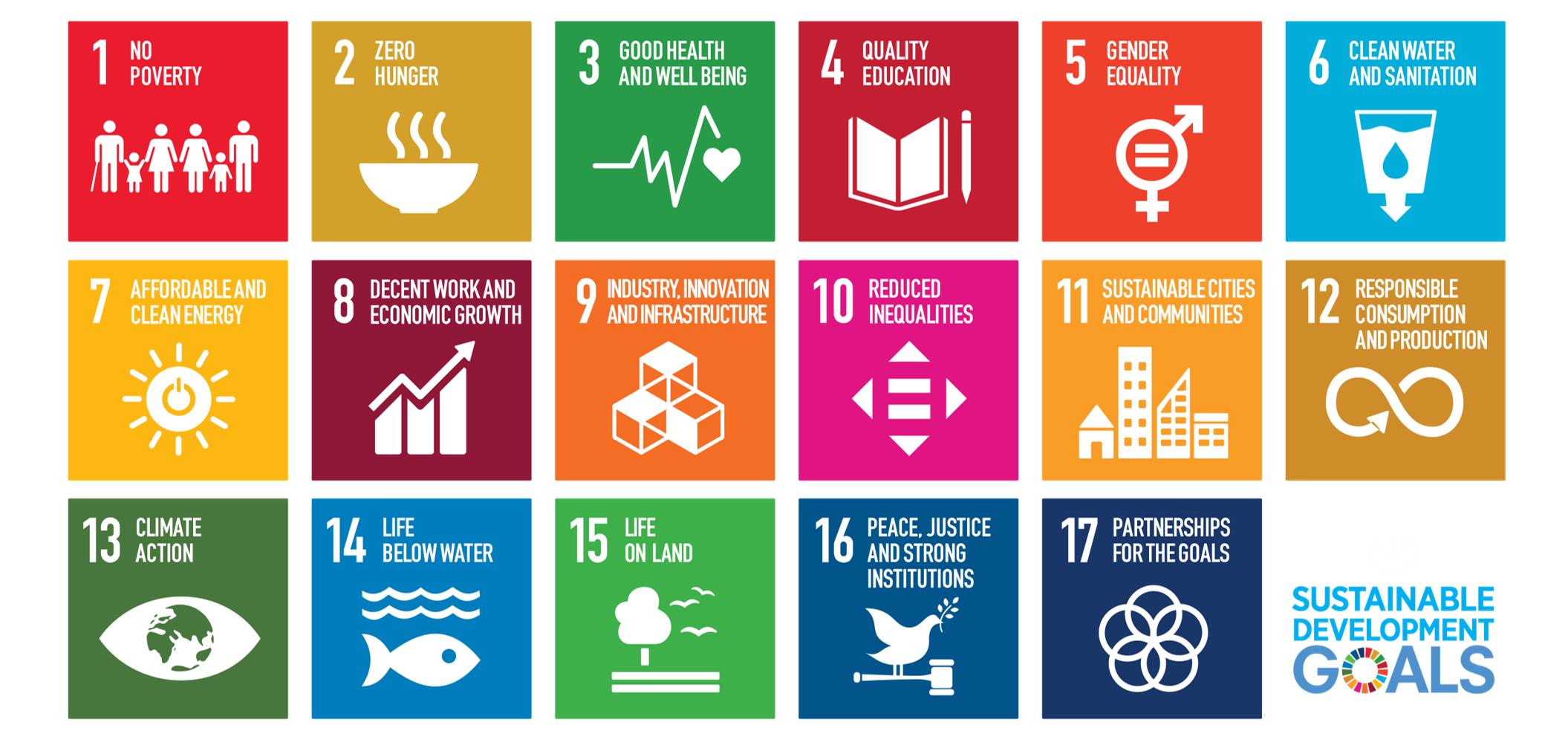
Source: UN, 2015
Therefore, the Sustainable Development Goals (SDGs) address the areas of action which are targeted in order to reach “the future we want”. The SDGs 2 (zero hunger), 6 (clean water and sanitation) and 7 (affordable and clean energy) directly address the demand for improving food, water and energy security.
According to the United Nations (2015), water, energy and food securities are key for development:
- A good diet is fundamental for the wellbeing of all humans and strongly impacts individual development and health
- Water is crucial for humans, for virtually all sectors and for the environment
- Industry and services depend on energy, and without energy, the standard of living is low
Although only the three highlighted SDGs directly address these securities, all other SDGs are linked in one way or another to improving water, energy and food security. Some examples are:
- Health (SDG 3) is directly related to the access to enough good quality food and water
- Resilience to natural hazards (11) depends on the way we manage water
- Consumption and production patterns (12) will determine our energy demands
- Education (4) and partnerships (17) will determine how to reach future WEF security
1.1.3 Nexus Concepts and History
- Sector specific goals may interfere with interests of other sectors
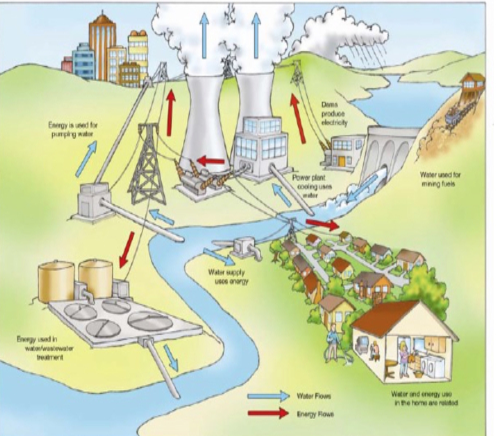
Source: U.S. Department of Energy, 2006
Example 1: Increasing electricity production affects water resources
- Goal: Increase energy security
- Energy generation requires water for cooling and mining
And as a result:
- Less water is available for other sectors and the environment, water is more polluted
- Less water security
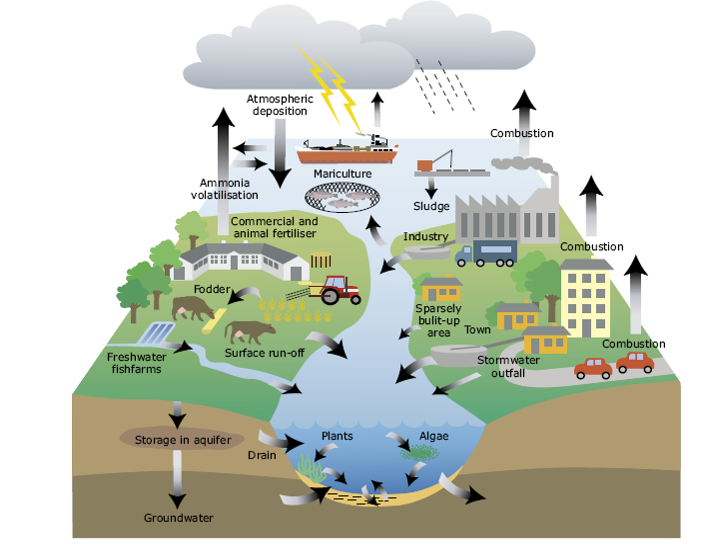
Source: LaB, 2010
Example 2: Intensifying agricultural production
- Goal: Increase food security
- Competition for land resources (eg. biofuels vs. crops as food)
- More use of fertilisers
And as a result:
- Contamination of water resources
- Less water security
→ Hence, there is a need for a systematic approach such as the WEF Nexus approach!
While the quest for development and the growing demands for energy, water and food will likely require an intensification in resources use, the achievement of one goal may negatively impact the performance of another goal. The increase of one security domain often has trade-offs with another security domain.
As energy production based on fossil primary energy resources and nuclear is water intensive (cooling and exploration requirements), the increased energy production may be at the cost of water security.
The second example refers to the potential impact of agricultural intensification. The positive effect on food security may be compensated by reduced water security as the downstream water is unfit for certain purposes due to water quality deterioration.
These trade-offs are the reason why a Nexus approach is needed: in order to systematically address what is often hidden or not being considered in planning and management, given that a “silo” approach (i.e. single mindedly pursuing individual goals) has no means to consider these types of externalities.
1.1.4 The Bonn 2011 Nexus Conference: The Water, Energy and Food Security Nexus
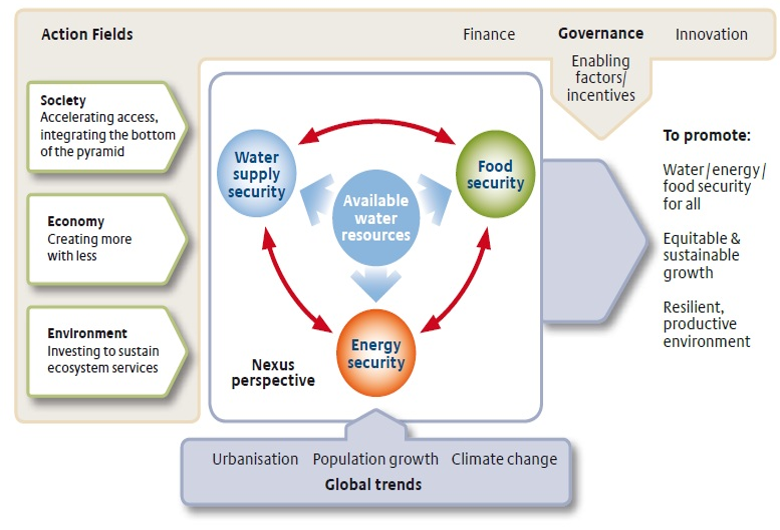
Source: Hoff, 2011
The WEF Nexus for the first time was raised at the World Economic Forum Annual Meeting in 2008, where representatives of the Water, Energy and Food sectors wanted to increase awareness that these are strongly linked, and that actions in one sector often have impacts on one or both of the others (WEF, 2009).
In November 2011, 550 researchers and stakeholders from worldwide met in Bonn, Germany, at the conference “The Water, Energy and Food Security Nexus – Solutions for the Green Economy”. The Conference Background paper for the Bonn2011 Nexus Conference presents initial ideas for how a nexus approach could enhance water, energy and food security by reducing trade-offs and building synergies across sectors. The development of ‘Understanding the Nexus’ has been coordinated and led by the Stockholm Environment Institute (SEI).
After this conference, the concept was adopted and promoted by many actors of policy, economy and academia. As a consequence, the Rio+20 summit, Sendai Framework for Disaster Risk Reduction and other high level global political agreements concerning sustainable development acknowledge the need for an integrated approach in addressing water, energy and food concerns.
This “first” Nexus concept (Hoff, 2011) looked at the security of water supply, food and energy from a water perspective: water is placed in the center of the Nexus. It also emphasized external driving forces such as urbanization, population growth and climate change, which all exert pressure to the system.
1.1.5 WEF Nexus from the ecosystem perspective: The Nexus Dialogue Program – GIZ/EU
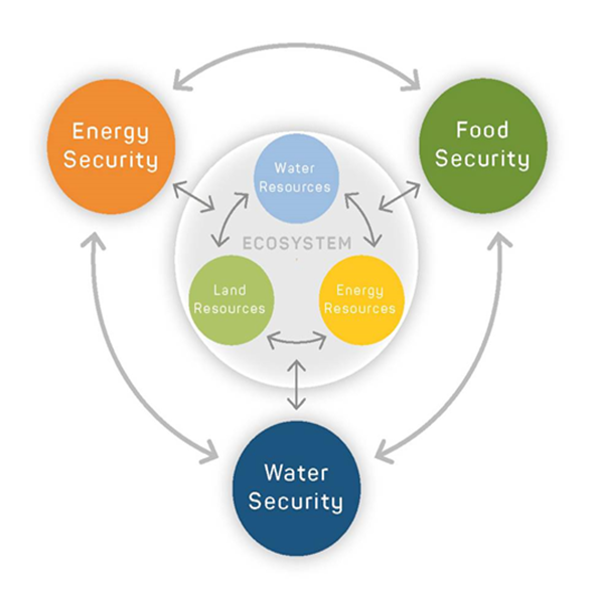
Source: GIZ/EU 2016
Since 2011, numerous concepts have been developed, each focusing on different aspects. The one developed to guide the “Nexus Dialogue Program” (GIZ, 2016), suggests a more integrated way of looking at the Nexus with the ecosystem located in the center. The three resources are equally allocated to it. The three ‘supply securities’ of water, energy and food depend on ecosystems and they interact with each other. The resources land, water and energy are part of this ecosystem and must be used and protected in a balanced manner.
The Nexus Dialogue Program was coordinated by the European Commission (EC, DG DEVCO) and the Deutsche Gesellschaft für Internationale Zusammenarbeit (GIZ) on behalf of the German Ministry for Economic Development and Development Cooperation (BMZ). The program aimed at supporting several Regional Nexus Dialogues: the Niger Basin with Niger Basin Authority (NBA), South African Development Community (SADC), in the Mediterranean Region by the League of Arab States (LAS), in Latin America by the Economic Commission for Latin America and the Caribbean (ECLAC) and the Latin American Water Directors, CODIA (with support from the Government of Spain), national governments and initiatives.
1.1.6 What are the benefits of WEF Nexus thinking?
- It helps to understand the complex and interrelated nature of different systems
- Identifies and evaluates trade-offs and synergies between different sectors to support decision making
- Supports sustainability pathways through the coordinated management and use of natural resources across sectors
- Facilitates the alignment of development strategies
The WEF Nexus emerged as a necessary reaction to failures of sector-driven management strategies. It represents the current need to engage in knowledge-based debates about the consequences of increasing interconnections between natural resources and the tools to improve the securities of water, energy and food at the same time. The presumption is that academia and policymaking lack such ‘integrated view’ on use issues of natural resources.
WEF security Nexus thinking hence aims at better understanding the links between these three sectors in order to improve both planning and development. Thus, it contributes to achieving water, energy and food security as pillars of development and well-being and reducing poverty.
By addressing trade-offs with other sectors and emphasizing the identification of synergies, the Nexus approach provides support for better decision making. This approach shows the mutual benefits of cooperation (between ministries, sectors, stakeholders, etc.). The WEF Nexus has emerged as an important conceptual framework for improving resource governance. By accounting for the complex interdependencies between water, energy, and food systems, such an approach can support decision-makers in managing resource tradeoffs across different economic sectors and actors.
References
1.1 Background: Challenges for achieving WEF-Security
UN 2020, The Sustainable Development Goals, https://www.un.org/sustainabledevelopment/
United Nations Department of Economic and Social Affairs (UNDESA) (2014) International Decade for Action WATER FOR LIFE 2005- 2015, http://www.un.org/waterforlifedecade/water_and_energy.shtml
Alexandratos N, Bruinsma J. 2012. World agriculture towards 2030/2050 (Available from http://www.fao.org/docrep/016/ap106e/ap106e.pdf (Accessed on 01.8.2020)
CGIAR Research Program on Climate Change, Agriculture and Food Security (CCAFS) (2020.), ‘Food Security’, https://ccafs.cgiar.org/bigfacts/#theme=food-security (Accessed on 02.8.2020)
1.1.2 The Sustainable Development Goals - Water, Energy, and Food Security: pillars of development!
United Nations General Assembly (2015) Transforming our world: the 2030 Agenda for Sustainable Development, https://sustainabledevelopment.un.org/post2015/transformingourworld.
UN 2020, The Sustainable Development Goals, https://www.un.org/sustainabledevelopment/
1.1.3 Why Nexus Thinking? Sector specific goals may interfere with interests of other sectors
U.S. Department of Energy (2006), ‘Energy Demands on Water Resources’, Report to Congress on the Interdependence of Energy and Water, https://ntrl.ntis.gov/NTRL/dashboard/searchResults/titleDetail/PB2011103657.xhtml
LaB (2010), ‘Fertilizers and their Impact on Watershed Ecology’, Available from: http://lab.visual-logic.com/2010/02/864/
1.1.4 The Bonn 2011 Nexus Conference: The Water, Energy and Food Security Nexus
WEF (2009) Water Security: The Water-Food-Energy-Climate Nexus, https://www.weforum.org/reports/water-security-water-energy-food/climate-nexus
Hoff, H. (2011). Understanding the Nexus. Background Paper for the Bonn2011 Conference: The Water, Energy and Food Security Nexus. Stockholm Environment Institute, Stockholm
1.1.5 WEF Nexus from the ecosystem perspective: The Nexus Dialogue Program – GIZ/EU
GIZ (2016), ‘Water, Energy & food Nexus in a Nutshell’, Available from: http://food.org/fileadmin/user_upload/files/2016/documents/nexus-secretariat/nexus-dialogues/Water-Energy-Food_Nexus-Dialogue/Programme_Phase1_2016-18.pdf